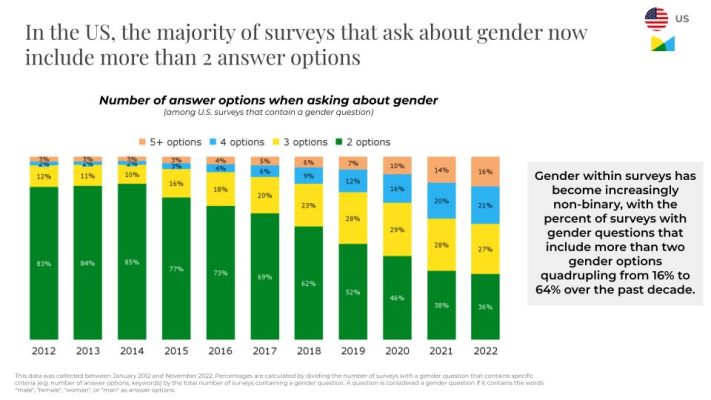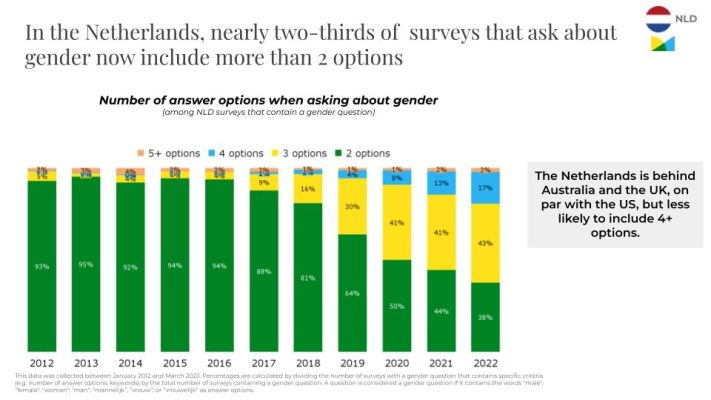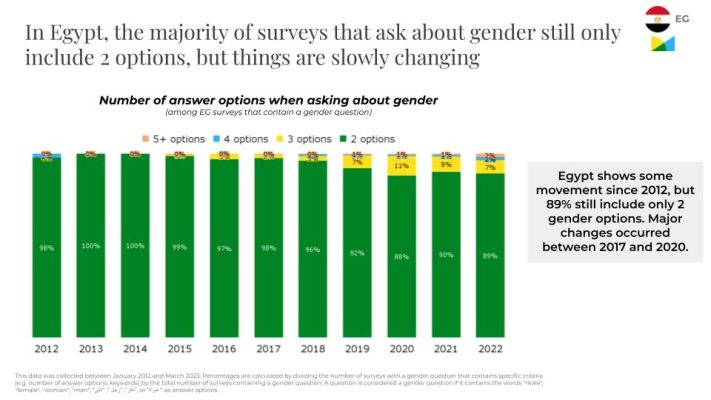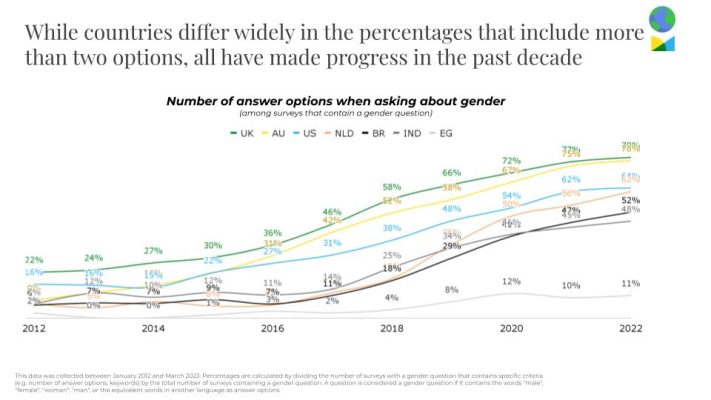A growing share of people around the world no longer view gender as a binary between male or female. In the past decade in particular, the gender inclusivity movement brought terms such as “transgender,” “gender non-binary,” and “gender fluid,” into everyday use. To keep up with those changes in cultural norms, SurveyMonkey users have changed how they ask questions about gender, too.
Building upon our State of Surveys report, our research team at SurveyMonkey analyzed all surveys taken on our platform from 2012 to 2022 in the US, UK, Australia, the Netherlands, Brazil, India, and Egypt. We identified the gender questions in all customer surveys, counted up the number of answer options included in each, and then aggregated the results at the country level.

In the United States, the use of three or more gender categories has quadrupled from 16% to 64% over the past decade. In 2022, 27% included 3 options, 21% included 4 options, and another 16% included 5+ options. Among surveys that asked about gender, one in five (21%) included ‘non-binary’ as an option, 13% included ‘other,’ and 7% included ‘transgender.’
The UK and Australia have seen the greatest adoption of additional gender options among the countries we studied. In 2022, more than three-quarters of surveys that asked about gender included three or more options in the UK (79%) and Australia (78%); up from 22% in the UK and only 9% in Australia a decade ago.

The Netherlands falls behind the UK and Australia, but on par with the US, with 62% including three or more gender options in 2022 (up from 7% in 2012). Surveys in the Netherlands included fewer gender options overall in 2022; 43% included three options but only 19% included 4+ options, about half as much as other countries (37% in the US, 48% in the UK, and 39% in Australia).
In other parts of the world, the pace of adoption has been slow but steady over the last five or six years. In Brazil, 52% of surveys that ask about gender now include three or more options, compared with 7% in 2016. A similar story plays out in India, where 48% now include three or more gender options, up from 11% in 2016.

Of the countries we examined, Egypt has been the slowest to pick up additional gender options. Between 2012 and 2018, the percentage that included three or more gender options hovered around 0% to 4%. In 2019, it increased to 8%, and in 2022 about 11% included 3+ options. In 2022, the vast majority (89%) of surveys taken in Egypt had gender questions with just two answer options.
Even though Egypt is an outlier, it still demonstrates the growth of more inclusive gender questions, just like the other six countries we’ve examined so far.

When we look at these seven geographically, culturally, and linguistically diverse countries together, we can see significant progress over the last decade. In most of these countries, more than half of SurveyMonkey surveys that ask about gender now include three or more gender options, becoming more inclusive of individuals who don’t identify as male or female.
Methodology
Percentages are calculated by dividing the number of surveys with a gender question that contains specific criteria (e.g. number of answer options, keywords) by the total number of surveys containing a gender question. A question is considered a gender question if it contains the words "male", "female", "woman", or "man," or the corresponding translations of those words, as answer options. Data for the Netherlands include Dutch, data for India include Hindi, data for Brazil include Portuguese, and data for Egypt include Arabic. This data was collected between January 2012 and December 2022.




